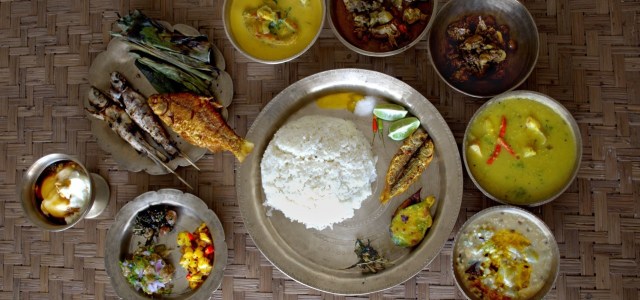
Assam is a small state tucked into the north-eastern corner of India. The culture leans more towards community rather than individual. Food is considered an important part of Assamese life. Meals are had with the family. Guests are revered and are often invited to lunch to share a meal. In one such experience, I was invited to lunch by a family. As I arrived, they greeted and escorted me from the gates. The host then invited me to the living room where we talked about different topics ranging from politics to sports. They served me with tea and light snacks. After our little chat, I was invited to the communal space to dine with the family. I was served with seelikha (horitoki) punch in a short glass. This they said is both an appetizer and helps in digestion. The punch had a sharp bitter taste but felt very refreshing. I noticed that the utensils used were made of bronze. When I enquired with the host, he said that traditionally meals were served on bronze plates even as it was easier to detect any foul substance which would react with copper in the alloy turning it either moss green or blue. I was served with small portions of every item cooked in the meal.

We started with gently steamed green leafy vegetables which was bitter and helped in cleansing my palate. Then we had the khaar or alkali preparation with rice. It had a light neutral taste. Next on the course was the red lentil or daal with elephant apple, which was slightly tangy mixed with the wholesome flavor of the red lentil. The pigeon meat was nicely done and paired well the rice along with the daal. The main course were two dishes, a duck curry with white pumpkin and a fish tangy curry. The white pumpkin balanced the rich flavor of the duck meat. The tangy flavor of fish curry then helped in balancing the overall taste of the dishes. On the sides, were barbequed fish wrapped in mustard leaves served in skewers and poppy seeds baked in pumpkin leaves. These added a unique crisp texture balancing the curries. Also as side dishes were served a eggplant mash, mixed green leafy vegetable fry and fried potato with bamboo shoots. To round of the meal, I was served with curd and jaggery as desserts. And lastly, keeping to tradition the host brought in a bronze basin and poured water from a bronze jug so that I can clean my hands and was given a handstitched traditional towel called gamosa to wipe my hands. Overall, the meal was very well prepared. I really liked how each preparation was tuned to the season and each ingredient was said to be have been beneficial during the summer when I had the meal. The balance of different flavors and tastes helped in creating a wholesome food experience. The preparation was also light and very little oil was used. This is by far the healthiest full course meal I have had which actually tastes out of this world. The age-old traditions and learnings of Assamese folk can really be experienced when having their home cooked gourmet meal.
Article by: Ajitesh Shankar Das
Check out the complete recipes in the book:
A Book of Gourmet by renowned culinary expert Jyoti Das Bardoloi.